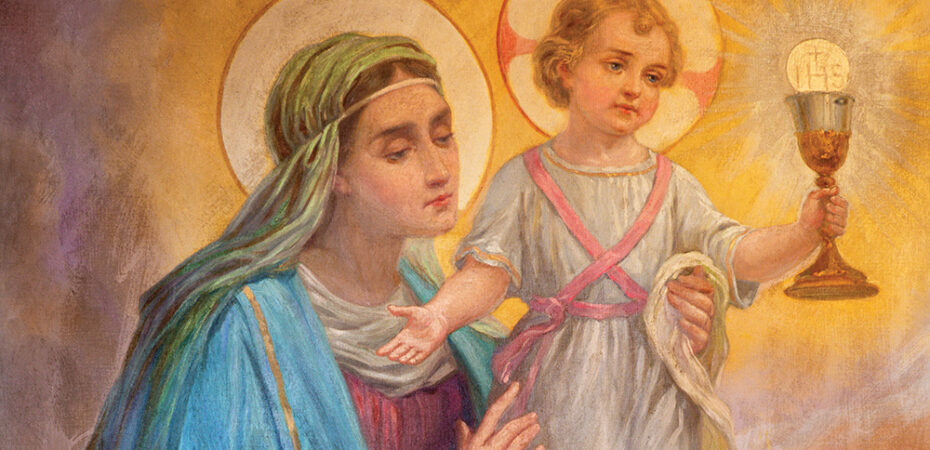On the Feast of the Holy Name of Mary
Mary’s name is holy and resplendent with many rich meanings
Robert Fastiggi Comments Off on On the Feast of the Holy Name of Mary
In the 2002 third typical edition of the Roman Missal — approved by Pope St. John Paul II — the feast of the Holy Name of Mary is included as an optional memorial. Some believe Pope John Paul II restored the feast of the Holy Name of Mary to the liturgical calendar because of the attacks on the World Trade Center in New York on Sept. 11, 2001. There seems to be a connection because Pope Innocent XI extended the feast of the Holy Name of Mary to the entire Latin rite in thanksgiving for the Sept. 12, 1683, Catholic victory over the invading Turkish army at the Battle of Vienna — a victory made possible by the forces of the Polish king, John Sobieski. The Holy Name of Mary was understood as a source of protection.
The feast of the Holy Name of Mary began locally in Spain in 1513, and it was celebrated on Sept. 15, the octave of the feast of Mary’s nativity (Sept. 8). Pope St. Pius V (r. 1566–72) abolished the feast, but Pope Sixtus V (r. 1585–90) reestablished it. By 1671, the feast was celebrated throughout all of Spain and in the Neapolitan kingdom. Innocent XI in 1683 changed the day of the feast to Sept. 12. Innocent XII (r. 1691–1700) moved the feast to the Sunday within the octave of Mary’s nativity, but St. Pius X (r. 1903–14) restored the feast to Sept. 12 in 1911. The feast of the Holy Name of Mary was dropped from the Roman Missal in 1970, but it was still retained as a votive Mass. St. John Paul II, though, included it in the 1986 Collection of Masses of the Blessed Virgin Mary and in the third typical edition of 2002.
We know that Jesus means “God saves” (Catechism of the Catholic Church, No. 430), but what does the name Mary mean? Father Richard Kugelman, CP, in his article on “The Holy Name of Mary” (Mariology, Vol. 1, ed. J. Carol, OFM., 1955, p. 411), notes that the most common meanings ascribed to Mary’s name by early Christian writers were “Bitter Sea,” “Myrrh of the Sea,” “The Light Giver,” “The Enlightened One,” “Lady,” “Seal of the Lord” and “Mother of the Lord.”
Etymological Theories
The different meanings of Mary’s name reflect different etymological theories. The most obvious etymology is from the Hebrew name, Miryām or Miriam, the sister of Moses and Aaron (cf. Ex 6:20, 15:20–21; Nm 12:1–16, 20:1; Dt 24:9; Mi 6:4). Some ancient rabbis believed Miryām comes from Mėrȗr, which means bitterness, and that Miryām was born during the bitter time of Egyptian oppression. The Greek Old Testament rendered Miryām as Mariám, and this led to the belief that the name meant “bitter sea” because of the Hebrew roots Mar (bitter) and Yām (sea). Another suggestion was that Miryām means “Myrrh of the Sea” from the Hebrew, Mor (myrrh) and Yām (sea). Still, another speculation was that Miryām meant she who causes light to shine — the Light Giver — because the Hebrew verb ‘ôr means to shine.
When Miryām was translated into Aramaic as Maryam other speculations emerged. One was that Maryam means “Lady” as a feminine form of Mar or Marya, the Aramaic word for Lord. Some scholars suggest that Miryām originates from the Ugaritic/Canaanite root Rwm (exalted), so the derived name Myrm means “the exalted one.” Others believe there might be an Egyptian etymology to Miryām, and the name comes from mr (to love) combined with Yām for Yahweh (God). Thus Miryām would mean “beloved of God.” Still others think the Egyptian root is mara, which means well-developed, corpulent or beautiful (according to the Egyptian and Semitic cultures). Some scholars also note that mara resembles the Hebrew verb Mārā, which carries the same meaning.
Church Historians
St. Jerome (c. 347–420) — drawing on some earlier Greek speculations — proposed various meanings for Miryām (Hebrew), Mariám (Greek) and Maria (Latin). Among these were “Lady,” “Light Giver” and Stella Maris (“star of the sea”). Some scholars believe Stella Maris was actually a mistake of a copyist, and that Jerome originally meant Stilla Maris (“a drop of the sea”), which was similar to “Myrrh of the Sea.” It was Stella Maris, though, that endured among later writers.
The Benedictine monk Rabanus Maurus (c. 780-856) proposed three plausible meanings for Mary: Light-Bringer, Star of the Sea and Domina (Lady). He preferred the first two because it “is normal for a star to guide men to a safe haven” (Homiliae in Evangelia et Epistolas 163: PL 110, 464c). St. Bernard of Clairvaux (1090–1153) also believed Mary meant “star of the sea,” and he writes: “Just as a star emits its rays without being corrupted, so the Virgin gave birth without any injury [to her virginity]. … Mary, I say, is the distinguished and bright shining star … gleaming with merits, giving light by her example” (Super missus est, 2 17: PL 183, 70–71).
St. Thomas Aquinas (1225–74) likewise identified Mary as “star of the sea,” and he states, “Just as sailors on the ocean are guided to a harbor by a star, so Christians are guided to glory by Mary” (Expositio super salutationem angelicam).
Conrad of Saxony (d. 1279) brought together several meanings of the name Mary, and he thought they all correspond to different aspects of her person and mission. In his Mirror, or Short Treatise, on the Angelic Salutation of the Blessed Virgin Mary — once mistakenly attributed to St. Bonaventure — Conrad writes: “This most holy, sweet and worthy name was eminently fitted to so holy, sweet and worthy a virgin. For Mary means a bitter sea, star of the sea, the illuminated or illuminatrix. Mary is interpreted Lady. Mary is a bitter sea to the demons; to men she is the Star of the sea; to the Angels she is illuminatrix, and to all creatures she is lady.”
St. Louis de Montfort (1673-1716) extended Mary’s association with the sea to her status as the storehouse or treasury of graces. In “True Devotion to the Blessed Virgin Mary” he notes: “God the Father gathered all the waters together and called them the seas (maria). He gathered all his graces together and called them Mary (Maria). The great God has a treasury or storehouse full of riches in which he has enclosed all that is beautiful, resplendent, rare, and precious, even his own Son. This immense treasury is none other than Mary whom the saints call the ‘treasury of the Lord.’ From her fullness all men are made rich” (No. 23).
As can be seen, the name Mary has been identified with a number of significant meanings. To honor her name is to honor her person, and it is most fitting to have a feast day celebrating her holy name, which has been understood as a terror to demons and a bright and shining star that leads us to heaven.
Other Linkages
It’s important, though, to note that the singular appearance of the Hebrew name Mary, or Miriam, in the Old Testament, is that of Miriam, the sister of Aaron and Moses. The link of Mary to the sister of Moses is also found in the Quran, where Mary (Maryam) is called “sister of Aaron” (Surah 19:28). Some scholars translate “sister of Aaron” as “kinswoman of Aaron” to avoid the suggestion that the Quran has confused Mary the mother of Jesus with the sister of Aaron. Others say sister of Aaron is a symbolic reference to Mary’s priestly service to God.
Although there are other women named Mary in the New Testament — for example, Mary Magdalene; Mary of Bethany; and Mary, wife of Clopas — there is only one Mary (Miryām) in the Old Testament.
Father Stefano Manelli, FI, believes Miryām, the sister of Moses and Aaron, is a figure of Mary. Moses is the liberator and Aaron is the priest, and Mary is associated with the redemptive and priestly roles of her divine Son (cf. Stefano Manelli, FI, “All Generations Shall Call Me Blessed: Biblical Mariology,” Academy of the Immaculate, $13.35, 1995). Moreover, Miryām is identified as “the prophetess” who leads the women in dancing and signing a hymn of thanksgiving to the Lord for liberating his people from bondage (Ex 15:20-21). This hymn anticipates Mary’s Magnificat (cf. Lk 1:46-55). In Micah 6:4, we read: “I brought you up from the land of Egypt, / from the place of slavery I ransomed you; / And I sent before you Moses, Aaron, and Miriam.”
As Father Kugelman explains: “The sister of Moses is an apt type of Mary, the Alma Socia Redemptoris, the coadjutrix of her divine Son in the liberation of mankind from the slavery of sin and the bondage of Satan” (“The Holy Name of Mary,” p. 423).
We don’t have a biblical narrative of Sts. Anne and Joachim explaining why they choose to call their daughter Mary. We do know, however, that the name of Mary is holy and resplendent with many rich meanings. She is indeed exalted, bright, beautiful and beloved of God. As the Star of the Sea, she guides us securely to heaven as the beloved associate of her divine Son.
ROBERT FASTIGGI, Ph.D., is a professor of systematic theology at Sacred Heart Major Seminary in Detroit. He is former president of the Mariological Society of America.





